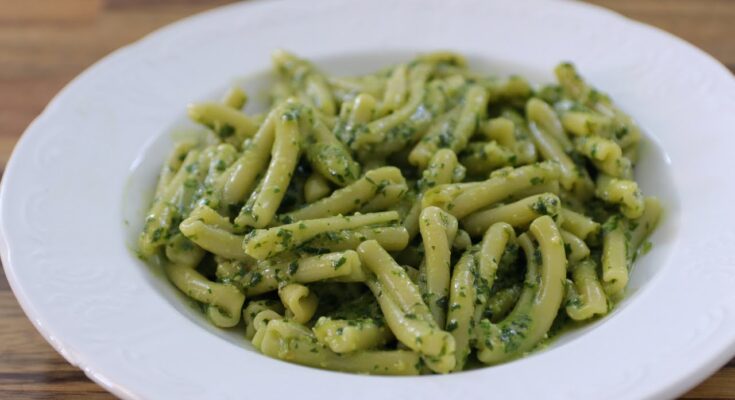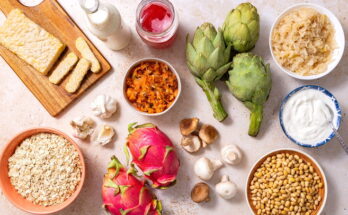Pesto Pasta Recipe: If there’s one dish that’s guaranteed to bring the taste of Italy into your kitchen, it’s pesto pasta. This vibrant and flavorful dish combines the earthy richness of fresh basil with the creamy nuttiness of pine nuts, Parmesan cheese, and olive oil. Whether you’re preparing it for a quick weeknight dinner or a weekend get-together, pesto pasta is a crowd-pleaser that’s both simple and satisfying.
But what makes pesto pasta so special? Apart from its mouthwatering taste, it’s incredibly versatile and easy to customize. You can whip it up in under 30 minutes, and the fresh ingredients make it a healthier alternative to heavy cream-based sauces.
Ready to dive in? Let’s get started with the ultimate step-by-step guide to perfecting this Italian classic.
Ingredients for Pesto Pasta
Essential Ingredients
To make the classic pesto sauce, you’ll need the following:
- Fresh basil leaves: The star of the show! Use high-quality basil for an aromatic flavor.
- Pine nuts: Toast them lightly to unlock their nutty essence.
- Garlic cloves: A couple of cloves are enough to add a savory punch.
- Parmesan cheese: Grated Parmesan gives the sauce its creamy texture.
- Olive oil: Opt for extra virgin olive oil for the best flavor.
Optional Ingredients
Want to switch things up? Here are some great variations:
- Spinach or arugula: Substitute part of the basil for a milder taste.
- Walnuts or almonds: Replace pine nuts with these affordable alternatives.
Choosing the Right Pasta Type
Not all pasta shapes are created equal when it comes to pesto!
- Long pasta: Spaghetti and linguine are excellent for a light coating of sauce.
- Short pasta: Fusilli or penne work well because their grooves hold the pesto beautifully.
Tools and Equipment You’ll Need
Before diving into the recipe, gather these tools to make the process seamless:
- Pestle and mortar: For a traditional approach to grinding the pesto.
- Blender or food processor: Speeds up the process for a smooth consistency.
- Large pot: To boil the pasta.
- Strainer: For draining the pasta.
- Mixing bowl: To combine the pasta with the pesto sauce.
How to Make Pesto Sauce
Step 1: Preparing Fresh Basil Leaves
Wash and pat dry the basil leaves. This step is crucial, as excess moisture can dilute the sauce. Opt for freshly picked leaves to get the best aroma and flavor.
Step 2: Toasting Pine Nuts
Toast the pine nuts in a dry pan over medium heat for 2-3 minutes. Stir them frequently to prevent burning. Toasting enhances their natural nutty flavor, adding depth to your pesto.
Step 3: Blending the Ingredients
Add the basil, toasted pine nuts, garlic, grated Parmesan, and a pinch of salt into a blender or food processor. Pulse a few times to combine. Slowly drizzle in the olive oil while blending until the mixture reaches a smooth consistency. Avoid over-blending to maintain a rustic texture.
Cooking the Pasta
Step 1: Choosing the Right Pasta
Choose pasta that complements the sauce. Fusilli’s twists and spaghetti’s strands both capture the pesto beautifully.
Step 2: Boiling the Pasta
Bring a large pot of salted water to a rolling boil. Add your pasta and cook until al dente (firm to the bite). This typically takes 8-12 minutes, depending on the type of pasta.
Step 3: Draining and Reserving Pasta Water
Before draining the pasta, scoop out a cup of the starchy pasta water. This will help thicken the pesto sauce and improve its coating ability.
Combining Pasta with Pesto Sauce
Transfer the cooked pasta into a mixing bowl while it’s still hot. Add the freshly prepared pesto sauce and toss to coat the pasta evenly. Use the reserved pasta water to adjust the sauce’s consistency, adding it a tablespoon at a time until the pesto clings perfectly to the pasta.
Optional Additions and Variations
Pesto pasta is a versatile dish that you can customize to suit your taste or dietary preferences. Here are some exciting options to elevate your pesto pasta game:
Adding Vegetables
- Cherry Tomatoes: Halve these juicy little gems and toss them in for a burst of sweetness and acidity.
- Spinach: Add a handful of fresh spinach leaves to the hot pasta and watch them wilt beautifully.
- Zucchini or Bell Peppers: Sauté thin slices of zucchini or diced bell peppers for a hearty twist.
Incorporating Proteins
- Grilled Chicken: Juicy, seasoned grilled chicken pairs wonderfully with pesto pasta.
- Shrimp: Lightly sautéed shrimp adds a seafood touch that complements the basil flavor.
- Tofu: For a vegetarian option, marinate and pan-fry cubes of tofu before mixing them in.
These additions not only make the dish heartier but also introduce a variety of flavors and textures.
Serving Suggestions
Presentation matters, even for a simple dish like pesto pasta! Here are some tips to make your dish irresistible:
Pairing with Side Dishes
- Garlic Bread: A crispy, buttery side of garlic bread perfectly balances the creamy pesto sauce.
- Fresh Salad: Toss together a mix of arugula, cherry tomatoes, and Parmesan shavings with a drizzle of balsamic vinaigrette.
Plating Like a Pro
- Use a pair of tongs to twirl the pasta into neat mounds on individual plates.
- Garnish with fresh basil leaves and a sprinkle of Parmesan cheese for a restaurant-worthy presentation.
Tips for Perfect Pesto Pasta
To ensure your pesto pasta turns out perfect every time, follow these expert tips:
- Balance the Flavors: Taste as you go. Add a squeeze of lemon juice if the pesto tastes too rich or heavy.
- Quality Ingredients: Use fresh basil, good-quality olive oil, and authentic Parmesan for the best results.
- Avoid Overheating Pesto Sauce: Pesto loses its vibrant color and fresh flavor when exposed to high heat. Toss it with warm pasta instead of cooking it on the stove.
These small adjustments can make a huge difference in the final dish.
Common Mistakes to Avoid
Even a simple recipe like pesto pasta can go wrong if you’re not careful. Here are some pitfalls to avoid:
- Overcooking Pasta: Always aim for al dente. Overcooked pasta turns mushy and doesn’t hold the sauce well.
- Using Stale or Low-Quality Ingredients: Fresh basil and good olive oil are non-negotiable for authentic pesto flavor.
- Forgetting to Reserve Pasta Water: This starchy water is essential for achieving a silky, well-coated dish.
How to Store and Reheat Pesto Pasta
Got leftovers? No problem! Here’s how to store and reheat pesto pasta while maintaining its flavor:
Storing Leftovers
- Place the pasta in an airtight container and refrigerate for up to 3 days.
- Keep the pesto sauce separate if possible to prevent it from soaking into the pasta.
Reheating Without Losing Flavor
- Heat the pasta gently in a skillet over low heat, adding a splash of water or olive oil to revive the sauce.
- Avoid microwaving, as it can alter the texture and taste of the pesto.
Health Benefits of Pesto Pasta
Pesto pasta isn’t just delicious; it can also be a healthy addition to your meal rotation. Here’s why:
- Rich in Nutrients: Basil is packed with antioxidants, while pine nuts provide healthy fats and proteins.
- Heart-Healthy: The olive oil in pesto is a great source of monounsaturated fats, which promote cardiovascular health.
- Customizable for Diets: Use whole-grain pasta or zucchini noodles to make it even more nutritious.
For a guilt-free indulgence, pesto pasta strikes the perfect balance between flavor and health.
FAQs about Pesto Pasta Recipe
1. What ingredients are needed for pesto pasta?
Pesto pasta typically requires pasta (like spaghetti or penne), fresh basil leaves, garlic, pine nuts, Parmesan cheese, olive oil, and salt. You can also add optional ingredients like cherry tomatoes, grilled chicken, or shrimp for extra flavor.
2. How do I make homemade pesto for the pasta?
To make pesto, blend fresh basil, garlic, pine nuts, Parmesan cheese, and olive oil in a food processor until smooth. Adjust the consistency with more olive oil if needed. Season with salt to taste.
3. Can I use store-bought pesto for this recipe?
Absolutely! Store-bought pesto works well if you’re short on time. Look for high-quality brands for the best flavor.
4. What type of pasta pairs best with pesto?
Pesto works well with long pasta like spaghetti, fettuccine, or linguine, as well as short pasta like penne or fusilli, which can hold the sauce in their ridges.
5. How can I make pesto pasta healthier?
To make it healthier, use whole-grain or gluten-free pasta, and reduce the amount of Parmesan cheese and olive oil. You can also add more vegetables like spinach or zucchini.
6. How do I store leftover pesto pasta?
Store leftover pesto pasta in an airtight container in the refrigerator for up to 3 days. Reheat gently on the stove or in the microwave, adding a splash of olive oil or water to refresh the sauce.
7. Can I make this recipe vegan?
Yes! Replace Parmesan cheese with a vegan alternative like nutritional yeast or vegan Parmesan to make the dish entirely plant-based.
8. What side dishes go well with pesto pasta?
Pesto pasta pairs wonderfully with a light salad, garlic bread, or roasted vegetables. A glass of white wine can also complement the dish perfectly.
Conclusion
Pesto pasta is a classic Italian dish that’s easy to prepare, endlessly customizable, and always a hit. From the rich, nutty flavor of homemade pesto to the perfect al dente pasta, this recipe brings the authentic taste of Italy right to your plate. Whether you enjoy it as-is or enhance it with vegetables and proteins, it’s a dish you’ll come back to time and time again.
Ready to give it a try? Grab your ingredients and whip up this delightful dish—it’s guaranteed to impress!



